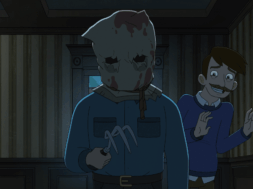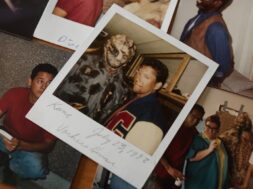Effects Designer Jim Doyle Shares Vintage Footage of ‘A Nightmare on Elm Street’s Rotating Room [Video]
The premise of Wes Craven’s A Nightmare on Elm Street allowed for some of the most imaginative deaths in horror, including Tina (Amanda Wyss) getting dragged across the ceiling and Glen (Johnny Depp) being reduced to an Old Faithful-like fountain of blood in his bed. Both of these classic effects were accomplished using the famous “rotating room.”
Jim Doyle, the film’s Mechanical Special Effects designer, also known for designing Freddy Krueger’s glove and playing Freddy’s arm in the bathtub, just shared a new video to Vimeo of behind the scenes footage of the rotating room as well as news coverage from 1984 when A Nightmare on Elm Street was in production. The video also includes footage from Breakin’ 2: Electric Boogaloo (1984); Doyle managed the special mechanical effects on that film as well, and Elm Street‘s rotating room was again used.
In Never Sleep Again: The Elm Street Legacy, Doyle explains: “Since Wes wanted something really big and fantastic and out there for the first death, I suggested that we do a rotating room.”
“Fluids can flow uphill, characters can rise, they can walk up walls, they can fall from ceilings,” a young Craven describes the rotating room in one of the vintage clips. “We can deal as dreams do with things that are sort of in violation of gravity… a violation of time and space.”
Given that the film was so low-budget, the special effects team had to get smart about how to bring this ambitious effect to life.
“The room was not motorized,” Lou Carlucci, special effects assistant on the film, explains. “It was so totally balanced after we were finished that one person could actually turn the room by hand.”
The team had to be very careful in securing the set’s scenery. “You could never feel like that room was turning,” says Carlucci. Otherwise it would give away the intended effect.
However, the room didn’t come without its challenges. Wyss experienced intense vertigo and it’s well-known that while shooting the blood geyser scene, the “blood” aka red water caused a little bit of a real nightmare for everyone on set. Once the liquid hit the light, the guy pouring the light was electrocuted, and then the water began to slosh around, throwing the room off-balance. It spun around as wires and sparks flew and the room became covered in the red water. Terrifying in the moment, to be sure, but the “fortuitous mistake” (as Rachel Talalay, the film’s assistant production manager, refers to it in Never Sleep Again) resulted in eerie and gruesome visuals for the final film.
Rotating sets and similar effects have also been used in films including Royal Wedding (1951), Poltergeist (1982), The Fly (1986), Interview With The Vampire (1994), and Inception (2010) as well as Matthew Wilder’s “Bouncin’ Off The Walls.”
Check out the vintage video footage provided by Doyle below.










